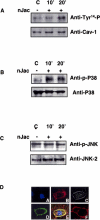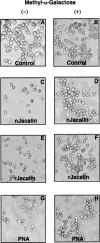Stress-induced phosphorylation of caveolin-1 and p38, and down-regulation of EGFr and ERK by the dietary lectin jacalin in two human carcinoma cell lines
- PMID: 16817319
- PMCID: PMC1484514
- DOI: 10.1379/csc-160r.1
Stress-induced phosphorylation of caveolin-1 and p38, and down-regulation of EGFr and ERK by the dietary lectin jacalin in two human carcinoma cell lines
Abstract
We have examined the A431 (human epidermoid carcinoma) and HT29 (human colorectal carcinoma) cellular responses evoked by lectins of dietary origin, Jacalin of Artocarpus integrifolia (native jacalin; nJacalin), peanut agglutinin (PNA) of Arachis hypogea, and recombinant single-chain jacalin (rJacalin), which has the same protein backbone but approximately 100-fold less affinity for carbohydrates than nJacalin. All three lectins (nJacalin, rJacalin, and PNA) are cycotoxic inhibitors of proliferation of A431 cells. However, cells recover once jacalin but not PNA have been removed from the growth medium. Treatment of nJacalin results in morphologically visible cell rounding while retaining the membrane integrity when treated at 40 microg ml(-1), but treatment with PNA did not induce such changes. The observed cell rounding was found to be due to stress as the phosphorylation of caveolin-1 (at tyr14), p38 but not c-Jun N-terminal kinase were up-regulated, while PNA did not up-regulate the phosphorylation of the same. Jacalin also down-regulated the phosphorylation of the epidermal growth factor receptor and extracellular signal regulated kinase in contrast to PNA, which failed to down-regulate the same. Confocal microscopic studies reveal that jacalin is not internalized, unlike the lectin of Agaricus bisporous. Analysis of the proteins that bind to an nJacalin-sepharose column revealed the binding of six to eight proteins, and significant among them is a protein at approximately 110 kDa, which appears to be oxygen-regulated protein 150 (ORP150) (endoplasmic reticulum chaperone) as identified by its isoelectric point, two-dimensional sodium dodecyl sulfate-polyacrylamide gel electrophoresis and mass spectrometric analysis. This 110-kDa band is detectable with anti-Hsp70 antibody because ORP150 has homology with Hsp70. Confocal microscopic studies reveal the presence of Hsp70-like proteins on the surface of A431 cells as revealed by immunostaining with anti-Hsp70 antibody. Moreover, overexpression of ORP150 in A431 cells has resulted in a dramatic protection of A431 cells against jacalin-induced toxicity, confirming that the jacalin-induced cytotoxicity is mediated through ORP150, and impairment of ORP150 functions with the help of jacalin makes the cells more susceptible to death due to stress. Our studies suggest that the cellular responses, as a consequence of lectin binding, may not be exclusively mediated by carbohydrate binding property alone, but other factors such as protein-protein interactions may also contribute to the observed cellular responses.
Figures








Similar articles
-
Studies on recombinant single chain Jacalin lectin reveal reduced affinity for saccharides despite normal folding like native Jacalin.Protein Sci. 2004 Dec;13(12):3264-73. doi: 10.1110/ps.04968804. Protein Sci. 2004. PMID: 15557267 Free PMC article.
-
Modulation of PP2A activity by Jacalin: is it through caveolae and ER chaperones?Glycoconj J. 2010 Oct;27(7-9):723-34. doi: 10.1007/s10719-009-9258-5. Epub 2009 Oct 13. Glycoconj J. 2010. PMID: 19823931
-
Increased ERK phosphorylation and caveolin-1 expression on K562 human chronic myelogenous leukemia cells by jacalin, a dietary plant lectin.Glycoconj J. 2021 Jun;38(3):361-368. doi: 10.1007/s10719-021-09998-4. Epub 2021 Apr 9. Glycoconj J. 2021. PMID: 33835346
-
The lectin jacalin plus costimulation with anti-CD28 antibody induces phosphorylation of p38 MAPK and IL-4 synthesis-I.J Leukoc Biol. 2006 Apr;79(4):876-80. doi: 10.1189/jlb.0905512. Epub 2006 Jan 24. J Leukoc Biol. 2006. PMID: 16434693
-
Cloning of a novel lectin from Artocarpus lingnanensis that induces apoptosis in human B-lymphoma cells.Biosci Biotechnol Biochem. 2018 Feb;82(2):258-267. doi: 10.1080/09168451.2017.1415127. Epub 2018 Jan 10. Biosci Biotechnol Biochem. 2018. PMID: 29318910
Cited by
-
Jacalin-Activated Macrophages Exhibit an Antitumor Phenotype.Biomed Res Int. 2016;2016:2925657. doi: 10.1155/2016/2925657. Epub 2016 Mar 29. Biomed Res Int. 2016. PMID: 27119077 Free PMC article.
-
cDNA cloning and functional expression of the alpha-D-galactose-binding lectin frutalin in Escherichia coli.Mol Biotechnol. 2009 Nov;43(3):212-20. doi: 10.1007/s12033-009-9191-7. Epub 2009 Jun 12. Mol Biotechnol. 2009. PMID: 19521795
-
EGFR and p38MAPK Contribute to the Apoptotic Effect of the Recombinant Lectin from Tepary Bean (Phaseolus acutifolius) in Colon Cancer Cells.Pharmaceuticals (Basel). 2023 Feb 14;16(2):290. doi: 10.3390/ph16020290. Pharmaceuticals (Basel). 2023. PMID: 37259433 Free PMC article.
-
Jacalin-Curcumin Complex Sensitizes the Breast Cancer MDA-MB-231 Cell Line.Int J Mol Sci. 2023 Dec 12;24(24):17399. doi: 10.3390/ijms242417399. Int J Mol Sci. 2023. PMID: 38139227 Free PMC article.
-
Cytotoxicity of Frutalin on Distinct Cancer Cells Is Independent of Its Glycosylation.Molecules. 2021 Aug 4;26(16):4712. doi: 10.3390/molecules26164712. Molecules. 2021. PMID: 34443300 Free PMC article.
References
-
- Calvert ME, Digilio LC, Herr JC, Coonrod SA. Oolemmal proteomics—identification of highly abundant heat shock proteins and molecular chaperones in the mature mouse egg and their localization on the plasma membrane. Reprod Biol Endocrinol. 2003;1:27.1477-7827(2003)001[0027:OPOHAH]2.0.CO;2 - PMC - PubMed
Publication types
MeSH terms
Substances
LinkOut - more resources
Full Text Sources
Other Literature Sources
Research Materials
Miscellaneous
